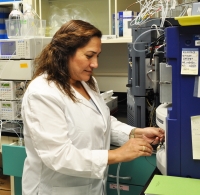
Welcome! Click on a tab below to find books, articles, and websites for use in this course.
You'll need a College of DuPage Library card in order to use most of the resources below from off campus.
Questions? Feel free to contact me, stop by the Reference Desk, or contact us by email or chat.
Biography/Contributions
One of the best places to look for information about your scientist is in the following sources:
First, do a search of Credo, an online database full of dictionary and encyclopedia entries.
Now, start looking for more information in the following books:
- Chemical achievers: The human face of the chemical sciences, by Mary Ellen Bowden
- Notable scientists from 1900 to the present
- Dictionary of Scientific Biography and the newer edition, which have different content
- Women in chemistry : their changing roles from alchemical times to the mid-twentieth century
- Nobel prize women in science
If your person was famous, you might check US Major Dailies to see if there is an obituary.
Still not finding much?
Check out the books on reserve for this project. You can also try a general search in the catalog to see if any books or entries exist. You are also welcome to use I-Share to request books from across the state for free. Some of you may find a hidden gem that will be a wonderful resource for your project.
Images
Many of you will be able to find images of your chemist on ImageQuest. You are also welcome to use any images you may find in Credo. You are also welcome to scan any images of your scientist that you may find in a book.
If that doesn't turn up anything, try looking at a Google Image search. Some of your scientists may even exist on YouTube-- see if you can find interviews or tributes that you can play clips of.
Molecule Information
Wikipedia is slowly becoming a reliable place to find molecular structures, CAS #s, and other chemical information. It's worth checking for an article about your topic, and then comparing the information you find to other sources.
Not finding any or enough info in Wikipedia? Head to SciFinder and use the Substance Identifier to get the chemical structure of the molecule and other properties. (Don't have a SciFinder account? If so, learn how to register for one here.)
Finally, not finding info online? Depending on what type of molecule you're researching, check the following books for either polymer information or biological molecule information.
Polymer Structure and Usage
- Handbook of Polymers Online
- Molecules at an expedition
- Polymer Chemistry: Properties and Applications Online
Biological Molecule Structure and Usage
Credo and Gale are also good places to look for more information on your biological molecules.
Environmental and Health information
Many of the sources above will have information about recycling/disposal and production of your molecules. Make note of any extra information you'll want to include in your presentation. Gale and Credo are again good sources for this information, as is Knovel.
Still looking for information? Try googling your molecule and EPA or and health to see what you find. Be sure to evaluate the website that you're looking at to make sure that it is one you should trust.
Citation Style
For the Works Cited Page:
You can find simple APA citation information on our library citation guide. You will also want to number your sources as they appeared in your presentation.
If you are nervous about creating citations, you're also welcome to check out NoodleTools, a program which creates and organizes citations. You'll want to create an individual account to use the program, and you must "Create a New Folder" when you use NoodleTools for the first time. Click on "I am citing a(n):," choose the type of item you are citing, and then fill in the online form. Your bibliography will be formatted for you.
In-Text Citations
Number each source on your work cited slide. Now, add numerical citations to each slide where one of your works cited is referenced.
For example:
Rachel Fuller Brown and Elizabeth Lee Hazen..... and synthesized nystatin (5).
Your audience would then know that the facts came from source #5 in your citation list.
You can see an example (short!) powerpoint presentation with citations here.